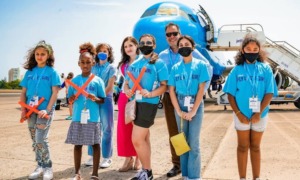 In 2013, an employer told a 14-year-old Florida boy named Blake Bryant to grab a chainsaw and then hoisted the teen, wearing a harness, high into a tree to trim branches. The inexperienced worker accidentally cut through the attachments to the harness and plummeted 50 feet to his death.
In 2013, an employer told a 14-year-old Florida boy named Blake Bryant to grab a chainsaw and then hoisted the teen, wearing a harness, high into a tree to trim branches. The inexperienced worker accidentally cut through the attachments to the harness and plummeted 50 feet to his death.
When I started doing child labor and child safety work 22 years ago, we were losing about 70 kids each year to occupational fatalities. In a typical year, we are now losing 20 to 25 teenagers at work. Encouragingly, in 2013, the total dipped to 14, but the following year — the last for which we have data — the total sprung back up to 21.
Our 2016 “Five Most Dangerous Jobs for Teens” report, updated annually with new data, provides guidance for teens, parents and employers about work safety and identifies five job categories we find particularly dangerous:
- tobacco harvester
- agriculture: Harvesting crops and using machinery
- construction and height work
- outside helper: landscaping and lawn service
- traveling youth sales crews
We’ve asked President Obama for help with the first category. We don’t understand how state and local governments can ban minors from smoking but still send children out into a tobacco field at 12 years old to be subjected to repeated bouts of nicotine poisoning. Our campaign partner Human Rights Watch documented this problem in a 2014 ground-breaking report, “Tobacco’s Hidden Children: Hazardous Labor in United States Tobacco Farming.” The world press registered alarm, and tobacco companies instituted policies to try to remove the youngest children from the fields, but not enough has happened to protect working children in tobacco.
The U.S. Department of Labor tried to ban child labor in tobacco work in 2011 as part of a set of regulations that would have protected child farm workers from more than a dozen dangers. Sadly, under political pressure, the White House withdrew the rules and went too far in saying they would never reissue them. Many years of work by health and safety advocates ground to a halt. Now, we are asking the President to revisit the rules by protecting teen tobacco workers.
[Related: Working Ranch Integrates ACEs, Animals into Treatment for Teens]
We’re also working with Congress to protect child fruit and vegetable harvesters, who are allowed by law at age 12 to work unlimited hours (as long as they are not missing school), performing back-breaking labor in extreme heat. They face obvious dangers posed by razor-sharp tools and machinery, and unknown dangers from toxic pesticides. Congress should close loopholes that go back to the late 1930s, when the Fair Labor Standards Act eliminated most forms of child labor in the U.S. but exempted farms.
We urge the enactment of the Children’s Act for Responsible Employment, the CARE Act, introduced every Congress for more than a dozen years by Rep. Lucille Roybal-Allard, D-Calif., which would remove the agricultural exemptions. If a 12-year-old can’t work in an air-conditioned office, why should he be allowed to perform hard labor on a farm?
Sadly, neither Congress (excluding two dozen progressive legislators) nor the president seem to be in a hurry to protect children. Without these policy changes, we are left mostly to raise awareness and focus on training. That’s where you can help by raising work safety as a discussion topic with teens about to enter the workforce.
There is a shocking variety to the way teens die or are injured in the workplace, and every death is a lifelong trauma for the families affected. Here are some recent examples of teens dying on the job:
- In December 2015, 19-year-old Mason Cox in Gastonia, North Carolina, was working his first day feeding tree limbs into a wood chipper. The operator heard an unusual noise and found that Mason had been pulled into the wood chipper and killed instantly.
- Grant Thompson, 18, was killed by a snake bite while working in a pet shop in Austin, Texas, in July 2015.
- In October 2014, 18-year-old Jeremy McSpadden, Jr., of Idaho died while working a Halloween haunted hayride. While running and wearing a mask and trying to scare, customers, he lost his footing and fell under the rear wheel of a bus.
Our report tries to prevent tragedies like these by alerting parents, teens and those who work with teens to dangers: Most teens die in vehicle accidents, and young workers die disproportionately on their first day or first week at work — before they can accurately assess job dangers, learn proper safety procedures or feel comfortable communicating with superiors. We hope to empower teens to gain the confidence to tell an employer that they don’t feel safe doing a task.
We can all impart health and safety lessons to teens. It’s time to begin that conversation.
Reid Maki is NCL’s director of child labor advocacy and coordinates the 40-member Child Labor Coalition, which is co-chaired by NCL. The Five Most Dangerous Teen Jobs (2016) is available at nclnet.org and topchildlabor.org, the websites of the National Consumers League and The Child Labor Coalition.
More related articles:
Milwaukee’s Summer Jobs Program Grows Despite Funding Falloff
More Than a Salary: Summer Job Provides Important Lessons on Work and Life
President’s Budget Proposal Aims to Help Youth Get First Job
































